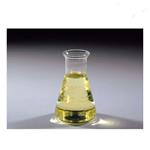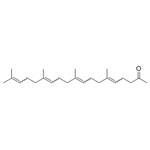Description
Teprenone (geranylgeranylacetone) is an antiulcer agent whose synthesis was
inspired by the gastric protecting properties of Coenzyme Q10. Teprenone is
reported to act via enhancement of gastric mucosal glycoprotein secretion.
Description
Geranylgeranylacetone is an inducer of heat shock protein (Hsp) expression that has been shown to increase Hsp70 (also known as Hsp72 and HspA1A), Hsp22 (HspB8), Hsp27 (HspB1), Hsp90 (HspC), and Hsp105 (HspH1) levels in various cells and tissues. It is orally bioavailable and has diverse effects
in vivo, including hepatoprotective, neuroprotective, and antiulcerative effects. The effects of geranylgeranylacetone on Hsp expression are more pronounced under stress conditions.
Chemical Properties
Yellow Oil
Uses
An anti-ulcerative. Geranylgeranylacetone can induce expression of HSP70, HSPB8, and HSPB1. Induction of HSP70 expression is protective against the development of various diseases, such as inflammatory bowel disease, hypoxic/ischemic brain injury and spinal and bulbar muscular atrophy (cytoprotective and anti-inflammatory effects). Reports indicate that GGA protects against NSAID-induced gastric and intestinal lesions by induction of HSP70 expression. Other studies have shown that GGA induces expression of HSPB8 and HSPB1 and reduces the formation of amyloid oligomers as well as insoluble aggregates in HSPB5 R120G TG mice.
Uses
Geranylgeranylacetone has been used as an inducer of heat shock protein 70 (HSP70) to analyze its protective effects against cerebral ischemia/reperfusion (I/R).
Definition
ChEBI: A terpene ketone in which a (9E,13E)-geranylgernayl group is bonded to one of the alpha-methyls of acetone (it is a mixture of 5E- and 5Z-geoisomers in a 3:2 ratio).
Biochem/physiol Actions
Geranylgeranylacetone can induce expression of HSP70, HSPB8, and HSPB1. Induction of HSP70 expression is protective against the development of various diseases, such as inflammatory bowel disease, hypoxic/ischemic brain injury and spinal and bulbar muscular atrophy (cytoprotective and anti-inflammatory effects). Reports indicate that GGA protects against NSAID-induced gastric and intestinal lesions by induction of HSP70 expression. Other studies have shown that GGA induces expression of HSPB8 and HSPB1 and reduces the formation of amyloid oligomers as well as insoluble aggregates in HSPB5 R120G TG mice.
References
1) Kamal and Omran (2013) The role of heat shock protein 70 induced by geranylgeranylacetone in carbon tetrachloride-exposed adult rat testes; Pathophysiology, 20 139
2) Lennikov et al. (2013) Induction of heat chock protein 70 ameliorates ultraviolet-induced photokeratitis in mice; Int. J. Mol. Sci., 14 2175
3) Adache et al. (2010) An acyclic polyisoprenoid derivative, geranylgeranylacetone, protects against visceral adiposity and insulin resistance in high fat fed mice; Am. J. Physiol. Endocrinol. Metab., 299 E764
4) Marunouchi et al. (2014) Protective effect of geranylgeranylacetone via enhanced induction of HSPB1 and HSPB8 in mitochondria of the failing heart following myocardial infarction in rats; Eur. J. Pharmacol. 730 140





